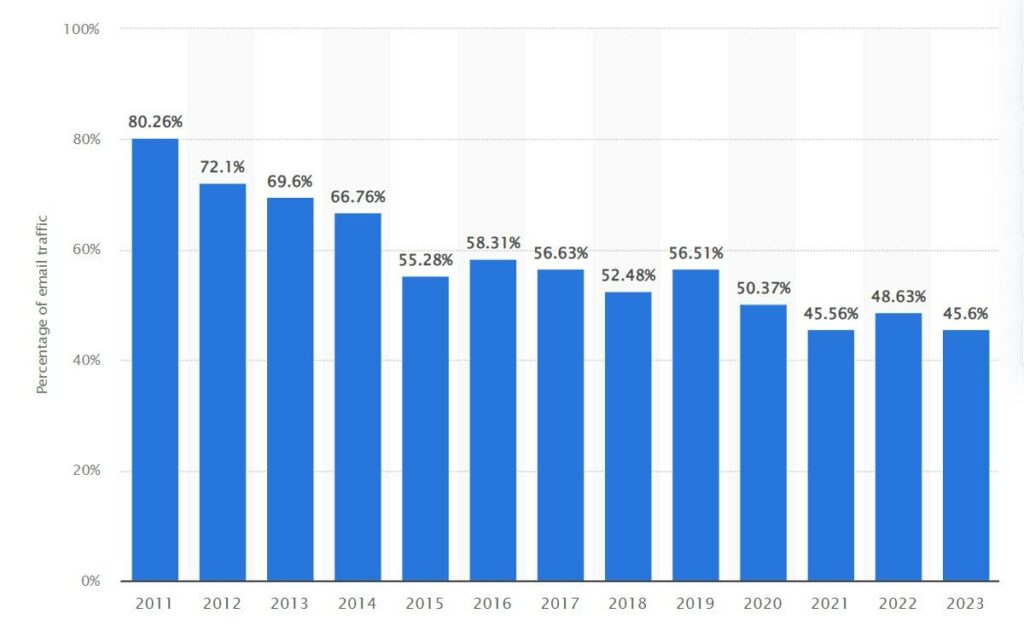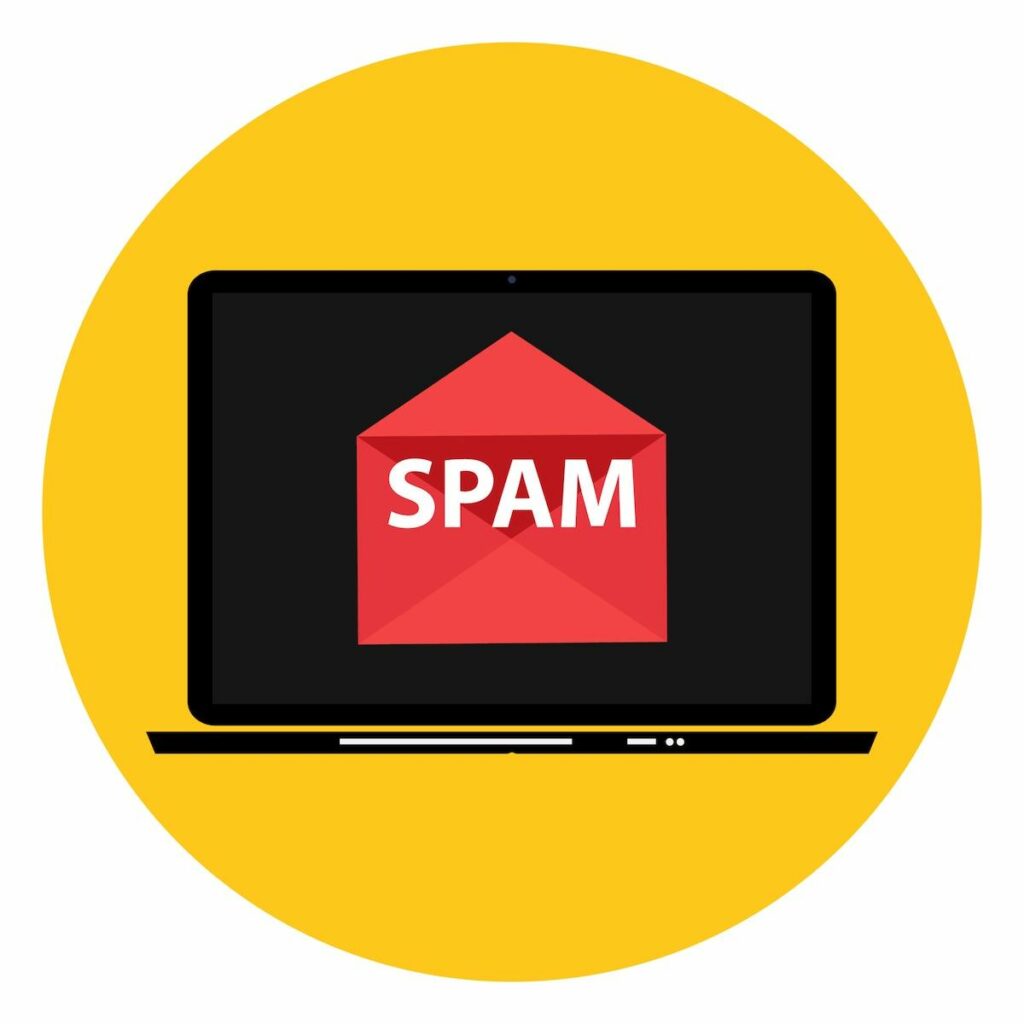How Spam Filtering Works: A Comprehensive Guide
It is difficult to imagine contemporary emailing without spam. Whenever you leave traces of an email address, there is a chance to receive junk email after some time. In most cases, they are just annoying. However, they can contain malware, explicit content, and different types of false information.
Back in 2011, around 80% of e-mail traffic belonged to spam. However, with the development of modern security practices, teaching internet users about online safety, and the implementation of spam filtering, the percentage of scam mail greatly decreased.
Spam filters are an effective way to protect yourself from unwanted messages. However, it can be unclear how exactly they work. That is why, this guide will shed light:
- What are the spam filters?
- How do they work?
- What types of spam filters exist?
- What are the challenges of spam filtering?
- What are the best practices for their implementation?
- What is the possible future of spam filtering?
So, let’s improve our awareness of spam filtering!
Understanding The Initial Spam Filtering Methods
The problem with spam appeared with the advancement of internet technologies. Back in the 1970s, people were just starting to become internet users. To utilize all its features, including sending emails, registering an email address was required.
However, with such accessibility arose a probability of receiving junk email. That resulted in the first spammer, Gary Thuerk, in 1978. He sent emails to 400 users of ARPANET to promote a new product of Digital Equipment Corporation.
Then, only in 1996, the Mail Abusive Prevention System (MAPS) was launched to protect users. It utilized a blacklist type of filtering that was updated periodically. The Real-time Blackhole List (RBL) analyzed the DNS of email senders to check whether they were on a blacklist.
The process of blacklisting email addresses was unclear, which resulted in blocking non-spam emails. Nevertheless, it was the beginning of spam filtering.
Exploring the evolution of email deliverability helps us appreciate the challenges that early internet users faced. With the advent of the Mail Abuse Prevention System (MAPS) in 1996, a significant stride was made towards safeguarding email communications.
MAPS introduced dynamic blacklists to curb the influx of spam, a move pivotal for the era. This early system not only blocked known spammers through its Real-time Blackhole List (RBL) but also paved the way for more refined solutions in email deliverability.
To further enhance email security and prevent spoofing, modern practices include adding DMARC records to your domain.
As the digital landscape evolved, the role of an email marketing specialist became crucial in ensuring emails reached their intended recipients without being marked as spam. They employ advanced techniques and strategies to optimize email deliverability and maintain sender reputation. Additionally, being active in a link building community can help email marketing specialists stay informed about the latest best practices for link building and email deliverability.
How Spam Filtering Works – Explained
Spam filtering is the process of detecting junk mail and protecting users by informing them about it or not receiving it. Filtering occurs according to different methods based on the filter type.
The main focus of spam blocking is to separate legitimate email from spam. Then, users will receive their important messages without mistakenly blocking them.
Types of Spam Filters
Each email that you send contains a lot of data, which is not just the content. That is what filters analyze. That results in various filtering types that focus on specific details to identify junk mail. Each one has its strong and weak sides. However, they are still developing to match the needs of the modern world.
Reputation-Based
This type pays attention to the reputation of incoming messages. The trustworthiness of senders depends on the previous emailing behavior. When analyzing the history of messages from one sender, it is possible to find data about them marked as spam. Then, the reputation of such senders becomes lower, which increases the chances of blocking the next emails.
The main difficulty for such filters is when the sender utilizes different email addresses with clear histories.
| Method | Description | Explanation |
|---|---|---|
| Implicit | Defines the reputation of a sender via the evaluation of previous emailing behavior. | The filter processes historical data to define the probability of a new email being spam without the user’s input. |
| Explicit | Defines the reputation of a sender via the direct feedback of the receiver. | After receiving emails, users need to manually mark them as junk mail or not to update the sender’s reputation. |
| Social networks | Utilizes the connection with social networks to determine the sender’s reputation. | It defines the trustworthiness of senders by analyzing their reputation within social networks. |
Traffic Analysis
Spammers often try to contact as many as possible addressees. That leads to abnormal activity that stands out among the rest of the traffic. By spotting such behavior, it is possible to apply filters to reduce or stop such activity.
Meanwhile, by approving certain senders, they can send multiple valuable emails without being blocked. That makes traffic analysis filters effective in protecting you from large-scale spam campaigns, ensuring that important emails about the best laptops or other significant topics reach your inbox.
| Method | Description | Explanation |
|---|---|---|
| Mail volume | Analyzes the volume of emails received from each sender. | By monitoring and registering a large number of emails within a very short time, it detects spam campaigns. |
| SMTP flow | Analyzes patterns and flows of Simple Mail Transfer Protocol (SMTP) connections. | The filter checks SMTP, including irregular patterns and fast connections, to spot any anomalies that notify you about junk mail. |
| Protocol-based | Utilizes email protocol features to detect and filter junk mail. | It pays attention to irregular email-sending patterns based on transmission behavior and header format that are part of protocol details. |
Origin-Based
The source of emails can also tell much about the quality of the content. When receiving junk mail from certain IP addresses and domains, it is possible to block them completely. So, these filters define trusted and untrusted sources to decide whether to block upcoming messages or not.
Similarly, to the previous type, spammers may utilize fresh emails from different sources to reach out to their targets.
| Method | Description | Explanation |
|---|---|---|
| Blacklists | Adds emails to a ban list due to known spam emails, IPs, and domains. | The filter maintains a database of spam sources to block any messages that outgo these domains and IP addresses. |
| Whitelists | Adds emails to a list of trusted sources to always allow them, regardless of the content. | It maintains a database of approved email addresses, IPs, and domains to ensure they always receive their messages. |
| Greylisting | Temporarily rejects emails from unknown origins and then accepts them upon retry. | Most mail services send their emails again if they are rejected. Most spam bots don’t utilize such a tactic. |
| Origin diversity analysis | Check the email source diversity to spot spam activity. | The filter analyzes the incoming messages from the sender to find any unusual behavior that could indicate junk mail. |
Content-Based
Another type of filter that focuses on what is inside an email is content-based. These blockers evaluate content and metadata to determine whether it is spam. There are two main sub-categories of methods that deal with spam identification.
| Textual Content | Machine Learning | ||
| Heuristic/Rule-based | Follows a predefined set of rules, which assigns scores to words and phrases that often occur in spam. The cumulative result determines whether an email is spam or not. | Naïve Bayes | Focuses on developing algorithms trained on labeled emails. It compares the likelihood of words and phrases in legitimate messages and junk mail. This method has the potential to improve over time. |
| Signature/Checksum Schemes | Processes each email and generates a unique checksum or signature to compare with an existing database of spam messages. | Support Vector Machines | A supervised learning model trains on labeled examples to find the optimal hyperplane to separate legitimate emails from junk mail. |
| Honeypots | To use decoy email addresses that attract spam messages to identify their characteristics. After that, systems can learn and detect spam based on evidence. | Clustering | Assigns emails into clusters based on their attributes but doesn’t label them. Then, it analyzes the cluster properties to find any patterns that differentiate junk mail from legitimate emails. |
| Digest-based | Compares new emails to summaries or hashes of known spam. It is effective against the repetitive tendency of receiving such emails. | Decision Trees | Utilizes tree structures of decisions to identify and classify incoming emails. It easily develops new solution branches but requires periodic calibration. |
| Fingerprint-based | Creates digital fingerprints of known spam messages. Then it compares them with incoming emails to find matches. | Ensembles | Utilizes the combination of various machine learning methods for higher accuracy. It leads to better performance than individual methods but is complex in implementation. |
Multimedia Content-Based
Incoming messages may contain other elements besides just text. Images, audio files, and personalized videos are multimedia that require attention too. Spammers can use them to avoid more common filters, such as those that process words and phrases. With the following methods, you’ll be able to worry less about annoying, ill-explicit, and dangerous content.
| Method | Description | Explanation |
|---|---|---|
| OCR techniques | Optical Character Recognition detects and extracts letters within images. | It analyzes and reads text content from images for spam indicators, applying filtering if needed. |
| Keyword detection | Analyzing multimedia via scanning to find keywords indicating spam. | Detecting keywords that are common in junk mail. Then blocking emails with images and videos that contain such words or phrases. |
| Text categorization | Evaluating emails and categorizing them according to text within multimedia content. | This filter type extracts text from multimedia and processes it to see if it falls into the spam category. |
| High-level analysis | Utilizing sophisticated multimedia content examination to spot junk mail. | It uses advanced methods for comprehending the context and semantics of multimedia to spot spam with deep analysis. |
| Low-level features | Paying attention to basic aspects of multimedia, such as texture and color. | Analysis of visual features and patterns at the pixel level. These characteristics can indicate spam in videos and images. |
| Image classification | Machine learning identifies, evaluates, and categorizes content as legitimate or spam. | Utilizes algorithms to recognize images and detect elements that often occur in junk mail. |
| Near Duplicate Detection | Identifying and filtering emails based on similar content in known junk mail. | Uses spam database to filter the nearly duplicate content of new incoming messages. |
Challenges in Spam Filtering
Spam filtering can cope with large amounts of versatile junk mail. However, there are still challenges that limit their capabilities and efficiency:
- Accuracy and precision: achieving and maintaining a high rate of spam detection and avoiding misclassifying;
- Evolving junk mail: spammers come up with new strategies to bypass filters;
- Email volume: processing numerous emails in real-time without causing delays;
- Balancing the user experience: ensuring a positive emailing experience by preventing junk email and not restricting legitimate communications due to suspicions;
- Malicious content and phishing: identifying malicious links or malware, as they require advanced technologies for accurate content analysis;
- Language and format: Understanding what is junk mail when content utilizes different languages and formats;
- Resource consumption: advanced filtering services require more resources to effectively function;
- User preference: understanding individual preferences for what is spam and what is not;
- Compliance with regulations: ensuring that filtering tools comply with privacy regulations;
- Integration into existing systems: not every system is flexible enough to adopt new filtering technologies.
Best Spam Filtering Practices
Spam is a common problem for numerous internet users. Filtering greatly assists them in keeping emailing safe. As for the best practices for being safe, you should consider the following:
User Education
As noted by Martal, a lead generation agency, maintaining clean, validated email lists is just as important as filtering technology for keeping outreach effective and compliant.
While filtering is the use of tools you can be safe while emailing with proper education. Take time to learn more about detecting spam manually. Then, you’ll always be suspicious and won’t trust unknown senders. Then, you’ll always be suspicious and won’t trust unknown senders, similar to how Swarowski customers learn to distinguish genuine products from fakes.
Feedback
While filters help with junk mail, they are still far from perfect. They require user assistance to become better. You can provide feedback on the accuracy of the blocking so that next time it will perform better.
Regular Updating
While utilizing spam filters, they also need to be up-to-date. That ensures that these tools use the latest databases on junk mail and won’t fall for new spamming strategies.
Multi-Layered Filtering
Consider using several types of filters. That increases the spam protection rate and reduces the possibility for spammers to reach you. The selection of junk mail blocking tools should depend on your specific needs and the kind of junk mail that you receive.
The Future of Spam Filtering
Junk mail filtering tools have quite a promising future. The rapid development of artificial intelligence, especially natural language processing, ensures a better understanding of email content. AI-powered filters can actively learn and adapt to new challenges.
Integrating a spam checker into your email workflow adds an extra layer of protection, helping to identify suspicious patterns and reduce the chances of spam reaching your inbox.
This technology is not limited to email filtering; for instance, an AI dialogue generator can create realistic conversations, potentially complicating the task of distinguishing between genuine and automated communications.
Blockchain technology has powerful solutions for ensuring email source legitimacy. Senders will take care of their reputation as bad emailing records can be changed. Email encryption is another approach for greater content safety.
To Sum Up
Spam filtering is a complicated process that utilizes different methods to protect users. Sometimes they are effective, and sometimes not. The battle with spammers continues. However, these filters become better, leaving fewer chances for bypassing them. Thus, we can hope that they’ll be able to defeat all the junk mail and keep emailing safe.





